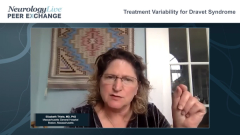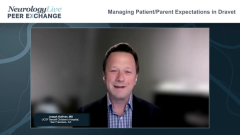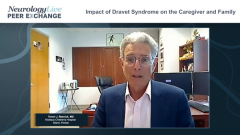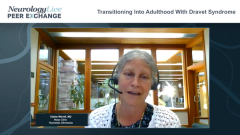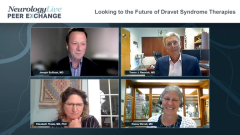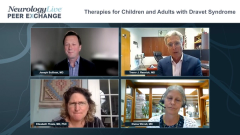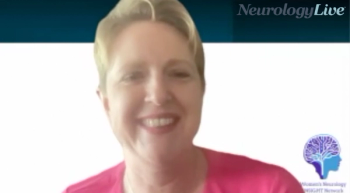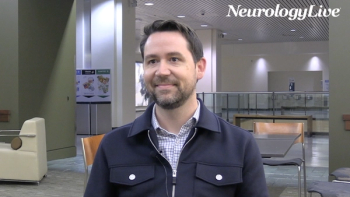
Dravet Syndrome Overview
Elizabeth Thiele, MD, PhD, and Elaine Wirrell, MD, provide an overview of Dravet syndrome and the seizure triggers in pediatric patients.
Episodes in this series

Joseph Sullivan, MD: Hello and welcome to this NeurologyLive® Peer Exchange titled “Redefining Treatment Outcomes in Dravet Syndrome.” My name is Dr Joseph Sullivan, and I’m a professor of neurology in pediatrics at the [UCSF Benioff Children's Hospital, San Francisco CA] where I also direct the Pediatric Epilepsy Center of Excellence at Benioff Children’s Hospital. Joining me today in this virtual discussion are my colleagues, Dr Trevor Resnick, chief of neurology at Nicklaus Children’s Hospital in Miami, Florida; Dr Elizabeth Thiele, director of the pediatric epilepsy program, director of the Herscot Center for TSC [Tuberous Sclerosis Complex] at Massachusetts General Hospital, and professor of neurology at Harvard Medical School in Boston; and Elaine Wirrell, director of the pediatric epilepsy clinic at Mayo Clinic in Rochester, Minnesota. Today, we’re going to discuss a number of topics pertaining to Dravet syndrome, including diagnosis and treatment. Let’s get started on our first topic. Elizabeth, would you mind giving us your description of what Dravet syndrome is, starting with how these children present?
Elizabeth Thiele, MD, PhD: Sure, I’d be happy to. All of us here have a very special interest in Dravet syndrome and take care of many children living with it, as well as their families. The onset of Dravet syndrome occurs around 5 to 6 months of age in children who were otherwise previously completely healthy. These children have normal development and are very social and interactive. At that age, typically in the setting of fever, they’ll have a seizure that is either hemiclonic—jerking of 1 side of the body—or clonic. They may have a second similar seizure, also in the setting of a fever, soon after. That usually happens in the following month or so.
An EEG [electroencephalogram] done initially after that first or second seizure is typically normal. What causes us to think this could be Dravet syndrome is that the children, in the second year of life, have onset of different seizure types: tonic, myoclonic, and atypical absence. In addition to the onset of these mixed seizure types, children typically have a plateau in their development at that time, and occasionally aggression.
Although Dravet syndrome is considered rare—your work allowed us to see the prevalence is about 1 in 15,700 or 1 in 16,000—it’s not as rare as other disorders. It was described by Charlotte] Dravet, MD, in a clinical presentation when she recognized how similar these features were these children had. Several years ago, the gene causing Dravet syndrome in many children was identified, the SCN1A gene, which encodes a sodium channel. That’s the typical presentation of Dravet syndrome. Especially over the past 15 or 20 years, we’re beginning to understand more about the phenotypic spectrum of Dravet syndrome as well as the natural history. Dravet syndrome is a very important epilepsy we treat in pediatrics.
Joseph Sullivan, MD: As a channelopathy, SCN1A is a channel that’s important in the brain. How does this result in seizures? There’s been some work done looking at the sodium channel and the inhibitory interneurons. When you have those inhibitory interneurons, the way we explain epilepsy to parents is that there’s too much excitation or too little inhibition. If you have those inhibitory interneurons that aren’t working correctly because of dysfunctional expression of sodium channel, you end up having a brain that has less inhibition and, therefore, they have more seizures. That doesn’t explain why children who do not have mutations in the SCN1A gene have Dravet syndrome, but that’s certainly a hot topic for future study. You mentioned fever. Elaine, could you speak to some of the other triggers that happen in these children? This is important for clinicians to know as we counsel our families.
Elaine Wirrell, MD: As Elizabeth said, the most important trigger is fever. It is a fever-induced seizure for probably over 75% of children when they initially present. They’re often initially felt to have had an atypical febrile seizure. For virtually all children afterward, fever—which is often actually pretty low-grade fever—or intercurrent infection is a very strong trigger. Another trigger would be warm ambient temperatures. Some children are triggered if you put them in warm water. If it’s a warm day outside, that can be a trigger for many children. Excitement or a lot of physical activity can also drive up the body temperature a little.
Vaccination is also a trigger for some kids. It’s probably related to the fact that vaccines result in fever for many children. The first seizure occurs following vaccination for about 25% of children who initially present with Dravet syndrome. That doesn’t mean they shouldn’t be getting their subsequent vaccinations. We recommend that those are given, but it certainly can be a trigger. Many of us recommend using Tylenol or something to try to prevent the fever associated with vaccination. Other potential triggers include things like patterns or flashing lights. The triggers are a little more problematic in young children. Oftentimes in adulthood, people for whatever reason become less sensitive to those triggers.
Joseph Sullivan, MD: Thank you for watching this NeurologyLive® Peer Exchange. If you enjoyed the content, please subscribe to our e-newsletters to receive upcoming Peer Exchanges and other great content right in your inbox. Thank you.
Transcript Edited for Clarity
Newsletter
Keep your finger on the pulse of neurology—subscribe to NeurologyLive for expert interviews, new data, and breakthrough treatment updates.


